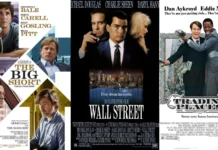Introduction to Stock Exchange and its Popularity in Film
The stock exchange has long fascinated filmmakers and audiences alike. It’s a world of fast-paced deals, high stakes, and often, moral ambiguity. The thrill of trading stocks and the drama behind financial markets provide rich material for storytelling. Movies about the stock market take us on rollercoaster rides through greed, ambition, and personal downfall.
From the glimmering skyscrapers to smoke-filled rooms where fortunes are made or lost in an instant—these films capture the essence of capitalism at its most intense. Whether you’re an investor yourself or just intrigued by the complexities of finance, there’s something captivating about seeing it all unfold on screen.
Let’s dive into some must-watch movies that showcase stock exchange film history. These cinematic gems reveal not just what happens in boardrooms but also how those events resonate throughout society. Grab your popcorn; it’s time to explore this fascinating genre!
Wall Street (1987)
“Wall Street,” directed by Oliver Stone, is a timeless classic that delves deep into the financial world of the 1980s. The film features Michael Douglas in an iconic role as Gordon Gekko, a ruthless corporate raider whose mantra, “Greed is good,” became emblematic of the era’s excess.
Charlie Sheen plays Bud Fox, an ambitious young stockbroker eager to make his mark. His journey through ethical dilemmas and moral compromises paints a vivid picture of ambition gone awry.
The cinematography captures the fast-paced life on Wall Street with dynamic visuals and gripping dialogue. It highlights not only the allure of wealth but also its devastating consequences.
This film resonated with audiences then and continues to influence how we perceive finance in popular culture today. Its impact stretches beyond cinema; it sparked discussions about capitalism that remain relevant in today’s society.
The Wolf of Wall Street (2013)
“The Wolf of Wall Street” is a wild ride through the excesses of finance. Directed by Martin Scorsese, this 2013 film showcases the life of Jordan Belfort, played masterfully by Leonardo DiCaprio.
Belfort’s journey from rookie stockbroker to millionaire tycoon reveals a world filled with opulence and moral ambiguity. The film dives deep into the culture of greed that permeates Wall Street.
Its energetic pacing and sharp dialogue keep viewers on their toes. With memorable scenes featuring outrageous parties and extravagant spending, it paints a vivid picture of 1990s financial excess.
The performances are electric. Jonah Hill’s portrayal adds humor amidst chaos, highlighting the absurdity in Belfort’s rise and fall.
Beyond entertainment value, it raises questions about ethics in finance. This duality makes “The Wolf of Wall Street” not just a tale but also a critique wrapped in glamour and debauchery.
Margin Call (2011)
“Margin Call” offers a gripping look into the chaos of the 2008 financial crisis. The film unfolds over a tense 24-hour period at a large investment bank. As employees discover alarming truths about their company’s precarious position, panic sets in.
The ensemble cast features Kevin Spacey, Paul Bettany, and Jeremy Irons. Each character grapples with moral dilemmas as they confront the impending fallout from risky investments. This creates an atmosphere filled with anxiety and urgency.
Visually striking and thematically rich, “Margin Call” reflects on greed and responsibility within high-stakes finance. Its sharp dialogue keeps viewers engaged while provoking thought about ethical standards in business practices.
Filmed almost entirely in dimly lit offices, it captures the sterile yet suffocating world of Wall Street during its darkest hour. The movie is both a cautionary tale and an insightful commentary on capitalism’s fragility.
The Big Short (2015)
“The Big Short” offers a gripping look at the financial crisis of 2008. It dives deep into the complex world of subprime mortgages and the impending economic collapse.
The film intertwines narratives from various perspectives, making it both informative and entertaining. With its innovative storytelling techniques, viewers are educated while staying engaged.
The standout performances by Christian Bale, Steve Carell, Ryan Gosling, and Brad Pitt bring depth to their characters. Each actor portrays real-life figures who saw the chaos coming before others did.
Director Adam McKay uses humor to highlight serious issues, breaking down complicated financial jargon into relatable concepts. This approach makes finance accessible even for those unfamiliar with stock exchange intricacies.
Not only does “The Big Short” critique Wall Street’s greed but it also raises questions about accountability in finance—timely themes that resonate long after the credits roll.
Trading Places (1983)
“Trading Places” is a classic that brilliantly marries comedy and finance. Released in 1983, it stars Eddie Murphy and Dan Aykroyd as two men from starkly different backgrounds whose lives are flipped upside down due to a cruel bet.
The film cleverly critiques class disparity while delivering laughs. Murphy’s character, Billy Ray Valentine, transitions from a street hustler to an executive—albeit under ridiculous circumstances. Aykroyd’s Louis Winthorpe III faces the harsh reality of falling from grace.
What makes “Trading Places” memorable is its sharp dialogue and unforgettable scenes. The dynamics between the characters highlight not just their personalities but also society’s attitudes towards wealth and privilege during that era.
Its portrayal of the stock market is both humorous and insightful, making viewers think about ethics behind trading practices. This blend keeps audiences engaged long after the credits roll.
Other Notable Mentions
Beyond the iconic films already discussed, several other titles deserve a nod in the realm of stock exchange film history.
“Boiler Room” (2000) explores the shady side of brokerage firms. It captures the high stakes and moral dilemmas faced by young brokers chasing wealth at any cost.
Then there’s “Enron: The Smartest Guys in the Room” (2005), a gripping documentary that delves into one of America’s biggest corporate frauds. It highlights how greed can corrupt even the brightest minds.
“The Insider” (1999) takes us inside Big Tobacco but reflects broader themes relevant to finance and ethics, showcasing corporate responsibility versus profit motives.
Another interesting entry is “Rogue Trader” (1999). This film tells the true story of Nick Leeson, whose risky trades led to Barings Bank’s collapse—a cautionary tale about unchecked ambition.
These films add depth to our understanding of financial markets and human behavior within them.
Impact on Viewers and Society
Films centered around the stock exchange can shape public perception of finance and investment. They often portray the thrill and risks associated with market behavior, drawing audiences into a world filled with ambition and greed.
These stories resonate deeply. Viewers may find themselves inspired or deterred from investing based on cinematic narratives. Characters like Gordon Gekko or Jordan Belfort become icons, influencing how society views wealth accumulation.
Moreover, these films spark conversations about ethical practices in finance. They challenge viewers to consider the consequences of unchecked capitalism and corporate greed.
As a result, they create an awareness that extends beyond entertainment. The impact is significant—shaping opinions and possibly even driving real-world financial behaviors among audiences who are eager to understand complex economic principles through engaging storytelling.
Conclusion
The allure of stock exchange films lies in their ability to blend drama, intrigue, and real-world economics. From the cutthroat atmosphere of Wall Street to the moral dilemmas presented in The Big Short, these movies capture a unique slice of human experience. They allow viewers to explore the complexities of finance while engaging with characters that often reflect society’s own ambitions and failings.
As we’ve seen through various titles, each film presents a distinctive take on market dynamics. Wall Street introduced us to Gordon Gekko’s infamous mantra, “Greed is good,” shaping public perception about capitalism for decades. Meanwhile, Trading Places offered a comedic twist on financial manipulation and social class disparities.
The impact these films have had on audiences can’t be overstated. They not only entertain but also educate viewers about economic principles and ethical considerations within trading practices. As people flock to streaming platforms looking for gripping narratives intertwined with investment strategies or corporate scandals, it becomes clear: stock exchange cinema holds an important place in film history.
Whether you’re a seasoned investor or simply curious about market mechanics, there’s something captivating about watching how filmmakers interpret this complex world. Each story leaves its mark—sparking discussions around morality versus profit and ambition versus ethics.
These cinematic portrayals continue to resonate today as they mirror our societal values and fears regarding wealth accumulation and financial success. The fascination with stock markets will likely persist as long as there are stories worth telling—and watching—for generations to come.











